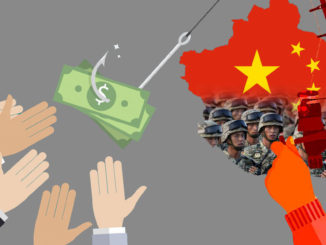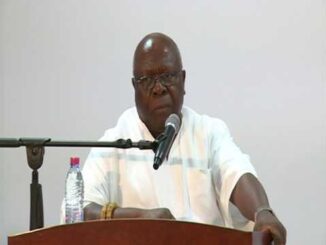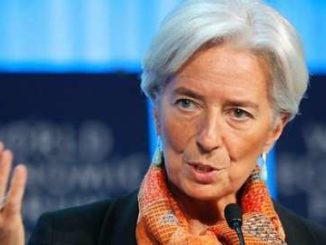A Book Review By Dikeogu Chukwumerije
Segun Adeniyi’s latest book is no shrinking violet. It announces itself from the first glance, leaving the browser in no doubt as to what it is about. The cover is headed by a quotation from Ghanaian President, Nana Akufo-Ado, in which the hope of the irregular migrant is bluntly referred to as ‘forlorn’. This idea – of futility – is not, thereafter, left to the imagination. It is re-enforced by the pictures on the cover – of a skull half-buried in the sand; of several black men sitting helplessly on a capsized boat; of two young women, one in a black hood with head bowed in anguish, while the other stands with raised chin, as if in defiance, but for the tears we can clearly see streaking down her face. And in her vacant stare into the distance is a sadness that speaks volumes. ‘How African Migrants risk everything in their futile search for a better life in Europe.’ Even if this were not the explicit sub-text to the book’s title, it would still be very clear – just from the cover design – what this book is about. And if by any chance it is not, then any confusions still lingering in the mind of a curious browser as to the purpose of this book, must surely be laid to rest by the book’s very title. ‘From Frying Pan To Fire’.
This is, of course, a popular proverb which, in spite of its apparent origins in ancient Greek literature, has been so thoroughly domesticated by the Nigerian tongue that I can confidently claim it as a Naija proverb. For it is one we use regularly to warn those thoughtlessly trying to escape a current predicament of the danger of running thereby into the clutches of a much greater one. And this is precisely what the book sets out to do, to show how the ‘frying pan’ the illegal migrant so bravely hurls himself or herself out of is often child’s play compared to the ‘fire’ they face on that arduous path to what they imagine must be a better life simply because it is to be had in a foreign country.
Style
To accomplish this tall objective, the book adopts a language that is down-to-earth and easy to understand, suggesting a lay audience as its target. The book also adopts an interesting style, employing a refreshing variation of voices and perspectives. By this I mean the book is not written in the voice of its author alone. I find at least four distinct types of voices at work in this book. First, in the introductory segment, we discover not one but, in effect, two forewords – one by Joy Ngozi Ezeilo, Dean of Law University of Nigeria, Nsukka and former UN Special Rapporteur on Human Trafficking, and the other by Nana Akufo-Ado, the current President of Ghana. In this way, the writer allows both eminent personalities to bring their unique and very learned perspectives to bear on the reader’s understanding of the subject matter. Further on, we discover a second voice – interjections by the writer himself in his personal capacity, where his subjective thoughts and opinions on the matter are freely expressed, andyou can feel his passion simmering beneath the typed words. This incarnation of Segun Adeniyi we read mostly in the opening and closing sections of this book. However, Adeniyi is also present in a more objective capacity in other parts of the book. For in significant sections of it, we find him writing in a different voice, in a distinct third voice, in the detached voice of that professional journalist we are more familiar with, studiously connecting the dots to tell the fact-based and objective story of irregular migration through statistics, interviews, and the faithful reproduction of the findings of academic research, thereby adding an important thread to the overall narrative texture.
Finally, the fourth voice. The very important fourth voice. For this book is also Segun Adeniyi A Book Review By Dikeogu Chukwumerije 86 THISDAY, THE SUNDAY NEWSPAPER NOVEMBER 25, 2018 written through the eyes and voices of its principal subjects – the irregular migrants themselves – creating a human angle to the narrative, an angle that helps to elevate the work beyond the status of an intellectual exercise, bringing the book home to the human heart.
In these personal, humanizing stories the book develops its capacity to provoke empathy in the reader – to draw a deep sigh, or a shocked gasp, to draw laughter, in some places, but more often than not it is tears that these stories provoke. Leading this symphony of human voices is the voice of the writer’s own brother – Agboola Adeniyi, himself an irregular migrant at one time. In fact, the bulk of the book – its entire second part, comprising of nine chapters – is told in Agboola’s voice. Interestingly, here, the writer permits Agboola to speak for himself.
This entails a refreshing switch from the third person perspective, with the writer in the role of the omnipresent narrator, to the more personal and intimate first person perspective, allowing us thereby to see the world as Agboola saw it, and to experience his many attempts to get to the First World, as he experienced it. Here, we share in Agboola’s hopes, in his fears, in his limited knowledge of what the future will be that serves to heighten the terror and exhilaration of every moment on his path.
In this way, by employing this interesting mix of voices and perspectives, this book not only tells the story of irregular migration, in the way a newspaper article would tell a story, but it also shows the story of irregular migration, in the way a fiction writer would tell a story, thereby fusing two writing traditions in one seamless work.
Structure
This integration of writing styles is facilitated in no small measure by the way the book is structured. ‘From Frying Pan to Fire’ is in effect a 4-part book. In the first and introductory section of the book, the writer documents important clues as to his personal motivation for writing the book, and the different influences that may have directly and indirectly shaped his thinking on the subject matter.
The substantive section of the book is thereafter split in two. Part One warehouses the journalistic style narrative that provides a fact-based and comprehensive overview of the subject matter, while Part Two contains the fiction style narrative that tells the story of irregular migration through the eyes of a migrant. The book then ends with a fourth and concluding segment where the writer summarizes, for the sake of emphasis, the critical factors driving irregular migration from the African continent and possible solutions to this problem.
This, if it still needs to be explicitly stated, is the book’s theme. The sheer scale of the problem of irregular migration is described in Chapter One, while its prevalence across different African countries is x-rayed in Chapter Three. Chapter Two is devoted to focusing attention on a particular strain of irregular migration for which Edo State in Nigeria has become infamous, namely the trafficking of young girls for prostitution. In this way, Part One of this book does what a typical work of fiction will not do for the reader, it sets out plainly the book’s thematic pre-occupations before proceeding, in Part Two, to illustrate them through the experiences of a single irregular migrant. In so doing, Segun Adeniyi’s work commits to highlighting – through objective analysis as well as subjective storytelling – the factors driving irregular migration from the African continent.
In his analysis, two critical factors emerge. Firstly, the state of affairs in the home countries of the irregular migrants. Using a popular story from the Christian Bible about three lepers who, faced with hunger and starvation in their city, decide to risk possible death in the enemy’s camp to search for food, Adeniyi makes the point that, ‘As things stand in Nigeria and most African countries today, irregular migration is more a necessity arising from desperation, than a conscious choice by those who embark on the risky journeys.’ Very closely aligned with this factor, Adeniyi points out, is the lack of concrete measures for repatriating and rehabilitating failed irregular migrants, leading to a situation where the failed irregular migrant, faced with the same socio-economic conditions that provoked the earlier attempt to escape, is forced to try again, and again, and again.
Secondly, Adeniyi argues strongly that irregular migration from the African continent is driven by ignorance on the migrant’s part about the true extent of the dangers to be faced. These dangers include the physical risks of crossing hostile deserts and oceans, the near certainty of de-humanizing exploitation by criminal elements along the way, and the violent and degrading xenophobia that is more often than not waiting for the irregular migrant at every stop.
These dangers combine routinely to turn the dreams of many a migrant, of better lives elsewhere, into nightmares. Judging from the time the book devotes to articulating and expounding on these dangers, it is clear that a principal objective of the writer is to fill this information gap, and warn potential irregular migrants of the deadly realities of that choice.
To accomplish this difficult task, of challenging the illusion of an El-Dorado waiting for the irregular migrant beyond the borders of his or her own country, the writer deploys the powerful tool of the personal stories of several migrants, none more powerful than that of his own brother, Agboola. Indeed, there are stories Agboola shares in this book that I, personally, find too sad to repeat, too cruel to re-tell, but which effectively carry out the function of slapping the dreamer awake.
Without a doubt, therefore, in Agboola Adeniyi’s development from a starry eyed 19-year- old dreaming of a better life in America, through the six desperate years he spends trying unsuccessfully to get into America or Europe, to his eventual evolution into a much ‘older and wiser’ person able to draw bitter lessons from the experiences of his younger self, Segun Adeniyi succeeds in de-constructing any fantasies one might have about irregular migration. This success is never more explicit than on page 61 when Princess, another failed irregular migrant, while reflecting on her own painful experiences, remarks, ‘I have never seen anything else like it in my entire life. As a woman in that situation, you want to die. If I ever see a woman wanting to take this route, I will ask her to kill herself instead.’
This ominous remark by Princess highlights the heightened nature of the risks faced by women in particular in the course of irregular migration. For it is too often the sad case that the lofty dreams of the young girl for better paying work in a hair salon in America or Europe ends in sex slavery somewhere in Mali or Libya, in Dubai or Italy.
Ultimately, this is what resonates most powerfully throughout this entire work – the sheer inhumanity witnessed and experienced by irregular migrants, the inhumanity of one human being to another, an inhumanity that, in the end, is fuelled by the curious belief that a man or a woman who enters another person’s country without permission is thereby a criminal, and not just a criminal, but the lowest of all criminals undeserving even of the most basic protections to be found in the law of the land. And yet where is the moral or ethical injunction that requires that a border be drawn between two neighbouring communities? And, therefore, what is the moral or ethical injunction that is broken when a man or a woman, in search of better opportunities, crosses an invisible line that politics has arbitrarily drawn in the sand?
These are the questions that are silently posed by the writer’s decision to refer to these migrants as ‘irregular’ and not as ‘illegal’. Because the modern criminalization of migration appears to be rooted, not in morality or any sense of a Natural Law prohibiting it, but rather in a politics of convenience, or what the writer refers to as ‘the ethics of the lifeboat’, whereby ‘rich countries are comfortably seated with enough space to accommodate more while wading off the miserable and desperate multitude…swimming and attempting to enter their boats.’
This sense of unfairness, in modern Immigration policies, is further heightened by the recollection of the historical role played, in the development of many of today’s rich countries, by outward, unrestricted and sometimes violent migration in yester-years to the so-called New World. It is these facts that create the impression of countries who have benefited from outward migration in the past but are now unwilling to allow others to do so today.
Whether outward migration, particularly of the poor and destitute, is in fact a natural and beneficial phenomenon that a developing country should be allowed greater room to exploit is a line of argument that can be further developed, either by this writer in another work, or by other writers seeking to explore ground not exhaustively covered in this work. For this work, ‘From Frying Pan to Fire’, while acknowledging the toxic effect of xenophobic and hypocritical attitudes to migration in the West, is decidedly, and perhaps correctly, inward- looking when it comes to the ultimate question of who is, principally, to blame for the thousands who die every year trying to cross the Sahara Desert, the Mediterranean Sea or the Atlantic Ocean. If, indeed, we are to take our own destinies into our own hands in any future Pan-African utopia then this must begin with us taking responsibility for ourselves today. We are to blame. We Africans – we Nigerians – must build the sorts of societies from which our citizens will not be so desperate to escape.
I quote, ‘Africa must tackle some of the underlying social problems, which facilitate human trafficking and irregular migration, such as poverty, low standards of living and gender inequality.’ These are the words of Joy Ngozi Ezeilo, Dean of Law University of Nigeria, Nsukka and former UN Special Rapporteur on Human Trafficking. These are the words that Segun Adeniyi himself chooses to end his impressive and well worth reading book, ‘From Frying Pan to Fire’, by concurring with. And following his very fine example, these are the words I choose to end this review of his book by concurring with as well.
Thank you.
–
thisdaylive.com




